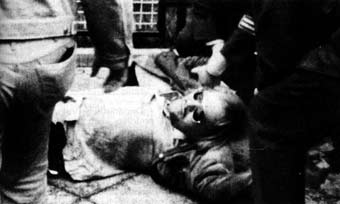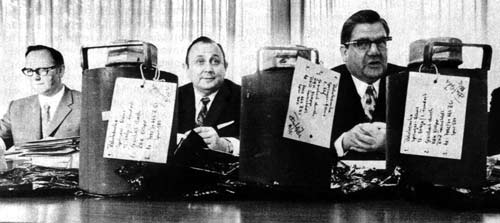Late 1972, Federal Republic of Germany
posted in 1972, Timeline |
Andreas Baader is brought to Berlin to testify in Horst Mahler’s trial. While on the stand, Baader takes the opportunity to publicly announce a hunger strike for all Baader-Meinhof prisoners. Word quickly spreads to the captured terrorists held in over ten different prisons across the Federal Republic.
December 11, 1972 West Berlin
posted in 1972, Timeline |
Till Meyer of Movement 2 June is sentenced to three years in prison for the attempted murder of a policeman.
September 20, 1972 Ossendorf and Zweibrücken
posted in 1972, Timeline |
Meinhof is transferred from Ossendorf Prison to Zweibrücken Prison to take part in an identification line-up. Meinhof is determined to ruin the process by screaming “I’M ULRIKE MEINHOF!” The police instruct the other women in the line-up to follow suit; the witnesses are treated the unforgettable spectacle of six women screaming and clawing at their guards; five impostors and one true criminal all screaming hysterically: “SWINE!” “THIS IS ALL JUST A SHOW!” and “I AM ULRIKE MEINHOF!”
September 5, 1972 Munich
posted in 1972, Timeline |
Any hopes that the days of the terrorism menace is behind them for the Federal Republic are put to a rest on September 5. Amidst the glory of the Olympic Games, “Black September” Palestinian terrorists capture Israeli hostages in the Olympic Village. A bungled rescue operation by the Bavarian state authorities leads to the deaths of all eleven hostages, five Palestinians, and one cop.
July 13, 1972 Federal Republic of Germany
posted in 1972, Timeline |
Lawyer and sometime Red Army Faction member Jörg Lang, who had brought Konieczny into the group, is arrested on suspicion of supplying the group with apartments.
July 7, 1972 Offenbach
posted in 1972, Timeline |
New Baader-Meinhof Gang member Hans-Peter Konieczny is cornered by police. He is quietly persuaded that the likelihood of him going to prison will be lessened if he aids in the capture of other gang members. Konieczny sets up Klaus Jünschke and Irmgard Möller, who are easily captured by the police. Konieczny is released from custody two months later.
June 25, 1972 Stuttgart
posted in 1972, Timeline |
Police burst in the apartment of a young Scottish businessman named Iain Macleod (they are acting on tips that he is involved with the Baader-Meinhof Gang). Macleod shrieks; the police shoot, killing him. Police never conclusively link him to the activities of the Baader-Meinhof Gang in any way.
June 15, 1972 Hanover
posted in 1972, Timeline |
Ulrike Meinhof and Gerhard Müller spent the past two days at the apartment of a teacher, who was a friend of one of Ulrike’s Schili connections. At first the teacher does not realize exactly who is sleeping under his roof, but he takes his suspicions to his girlfriend the next morning and then to the police. On 15 June, the police begin staking out the apartment. Müller leaves the apartment to go to use a phone booth. Police attempt to arrest him as he picks up the receiver. He pulls out his pistol, but is quickly wrestled to the ground. Later, much later, Müller will prove to be the most valuable catch of all of the Baader-Meinhof Gang; he will turn on his comrades and testify against all of them. For now, though, the police aren’t even sure who they have captured. Prior to his arrest no one had even suspected his involvement with the group.
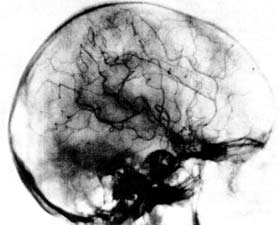
Because the police have no fingerprints of Ulrike Meinhof available, they X-Ray her brain to prove her identity. The X-Ray shows a tell-tale metal clip left over from a 1962 operation to stem an engorged blood vessel.
After Müller’s capture the police go upstairs to the apartment. They knock on the door and Meinhof answers. They take her into custody immediately. She seems shocked, and begins to cry. Initially she does not struggle, but after a few minutes she begins screaming and fighting. By the time she is photographed by the press at the police station a few hours later, her face is completely swollen. To many who see her face in the paper the next day, Meinhof surely has been beaten by the police.
Though they are fairly certain that they have captured Meinhof, the police do not have definitive proof. They do not have fingerprints of Meinhof to compare against. One of the police officers finds a copy of Stern magazine in the hide-out apartment; in it is an article about Meinhof. Accompanying the article is a photograph of an X-Ray of Meinhof’s brain, taken after an operation in 1962 when Meinhof had a metal clip placed over an engorged blood vessel in her head. One of the officers suggests that they X-ray her head to see if the woman that they have captured has a clip in her head. After forcibly anesthetizing Meinhof, an X-ray is taken, revealing the tell-tale clip.
June 9, 1972 West Berlin
posted in 1972, Timeline |
Baader-Meinhof Gang member (and original member of the SPK) Brigitte Mohnhaupt and Movement 2 June member Bernhard Braun are captured in Berlin.
June 8, 1972 Hamburg
posted in 1972, Timeline |
Gudrun Ensslin, almost beside herself with grief since the capture of her beloved Andreas, wanders into the Linette clothing boutique in Hamburg. After laying her jacket down to try on sweaters, a sales clerk notices that the jacket has a heavy bulge in a pocket. Closer inspection reveals that the bulge is a gun; she calls the police. Gudrun is taken into custody a short while later.
June 1, Frankfurt am Main
posted in 1972, Timeline |
Acting on a tip, police begin staking out a garage near Frankfurt. Peering inside, the police notice it is empty of people, but full of explosives. They empty the garage of bombs (replacing the explosives with empty containers), and install a listening device. City workers place hundreds of bags of peat and grass outside, as if preparing to plant grass. But the bags are filled with sand; the police are expecting a firefight.
1 June 1972, Frankfurt am Main – Andreas Baader, with a police bullet in his leg, is captured.
5:50 AM: a lilac-colored Porsche pulls up outside of the garage. Three men get out. One of the men notices that the surrounding roofs, windows and street corners are covered with dozens–no, hundreds–of men, milling about. Clearly they are cops. The man pulls out a gun and gets off several shots, but is tackled before hitting anyone. Jan-Carl Raspe is finally captured. The other two men–Andreas Baader and Holger Meins–make it into the garage, locking the double doors behind them.
A television crew shows up and begins filming the siege. The police drill a hole into the garage and push in tear gas canisters, but the gas mostly wafts into the apartments upstairs. After about three hours, Baader appears in the doorway, loading a magazine into his weapon. A police sniper shoots him, injuring his leg. He screams and retreats back into the garage. A few minutes later Meins gives himself up. The cops force him to strip to his undershorts to ensure that he isn’t carrying any weapons. After Meins’ capture the cops storm the garage, nabbing Baader.
May 24, 1972 Heidelberg
posted in 1972, Timeline |
Irmgard Möller and Angela Luther drive two cars onto the Campbell Barracks of the US Army Supreme European Command in Heidelberg. It is an easy enough job, the guards wave any cars with American license plates through; a pair of stolen plates ensures that they will not be stopped. Helped by Baader and Meins, Möller’s and Luther’s cars are equipped with 50 pound bombs. Möller and Luther surely notice that the area they park their cars in is frequented by soldiers and their families.
At around 6:00 PM Captain Clyde Bonner of the US Army and his friend Ronald Woodward are killed instantly when the car that Möller has driven blows up next Bonner’s new Ford Capri. Bonner is blown in half, his head and torso staying next to the car, with parts of his legs drooping off a nearby tree like wet leaves. The outside wall of the nearby base clubhouse collapses as well, knocking over a Coca-Cola machine, crushing and killing Charles Peck, another American soldier. Two days later in a communiqué, the “Commando Fifteenth July” (the day that Baader-Meinhof Gang member Petra Schelm was killed), claims responsibility for the bombings; they are “in response to American bombings in Vietnam.”
May 19, 1972 Hamburg
posted in 1972, Timeline |
Ulrike Meinhof, Siegfried Hausner, Klause Jünschke, and Ilse Stachowiak place six bombs in the Hamburg offices of the Springer Press. Three fail to explode, but the other three bombs blow up around 3:15 PM, injuring 17 people. “The 2 July Commando” claims responsibility.
May 15, 1972 Karlsruhe
posted in 1972, Timeline |
Baader, Raspe, and Meins put a car bomb in the Volkswagen of Judge Wolfgang Buddenberg, who had signed most of the Baader-Meinhof arrest warrants. Buddenberg’s wife, Gerta, is in the car when it explodes, severely injuring her. A communiqué is released claiming responsibility for the the bomb. It is signed, “The Manfred Grashof Commando.”
May 12, 1972 Augsburg and Munich
posted in 1972, Timeline |
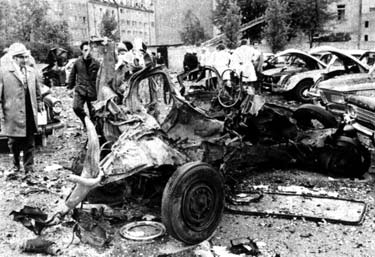
Andreas Baader is brought to Berlin to testify in Horst Mahler's trial. While on the stand, Baader takes the opportunity to publicly announce a hunger strike for all Baader-Meinhof prisoners. Word quickly spreads to the captured terrorists held in over ten different prisons across the Federal Republic.
Angela Luther and Irmgard Möller sneak into the Augsburg Police department and leave two time-delay pipe bombs. The bombs explode shortly after noon, injuring five policemen. Later in the Baader, Meins, and Ensslin leave a car bomb to explode in the parking lot of the state Bundeskriminalamt in Munich, destroying 60 cars. The Baader-Meinhof Gang, calling themselves the “Tommy Weissbecker Commando,” claims responsibility for both bombings.
May 11, 1972 Frankfurt am Main
posted in 1972, Timeline |
Andreas Baader, Gudrun Ensslin, Holger Meins, and Jan-Carl Raspe place three pipe bombs near the entrance the the I.G. Farben building, which houses the headquarters of the US Army Corp. The bombs explode within minutes of each other from 6:59 PM to 7:02 PM. The entrance to the officer’s mess is destroyed. A shard of molten metal flies from the bomb and lodges deeply into the throat of Lt. Colonel Paul Bloomquist. A decorated Vietnam veteran and father of two, Bloomquist bleeds to death at the entrance of the officer’s mess. Damages to the building are estimated to be DM 1,000,000. The Baader-Meinhof Gang, calling themselves the “Petra Schelm Commando,” claims responsibility in a communiqué, which demands the end to the American mining of North Vietnamese harbors.
March 29, 1972 Bielfield
posted in 1972, Timeline |
Till Meyer, Movement 2 June member, is arrested after a shootout in Bielfield. No one is injured.
March 15, 1972, Federal Republic of Germany
posted in 1972, Timeline |
Karl-Heinz Ruhland, the auto shop worker turned terrorist turned informer, is sentenced to four and a half years in prison for his participation with the Baader-Meinhof Gang.
March 2, 1972 Hamburg and Augsberg
posted in 1972, Timeline |
Hamburg police raid an apartment used by the Baader-Meinhof Gang for producing forged documents. In the evening, Manfred Grashof and Wolfgang Grundmann enter the apartment and are surprised by the police. Grundmann gives up immediately, but Grashof fires at the cops from behind Grundmann. Police Chief Superintendent Hans Eckhardt, who is in charge of Hamburg’s Baader-Meinhof Special Commission, takes two bullets. The other police return fire and shoot Grashof in the head and chest. Grashof will survive, but Eckhardt dies in Eppendorf University Hospital two weeks later.
In Augsburg police close in on a young couple that they had kept under surveillance for four weeks. A cop with an itchy trigger finger shoots Thomas Weissbecker, loosely connected to the Baader-Meinhof Gang and the Movement 2 June (and perpetrator of last year’s prison switch with Georg Von Rauch). Hit in the heart, Weissbecker dies instantly. His companion, SPK member Carmen Roll, is taken into custody.
March 1, 1972 Tübingen
posted in 1972, Timeline |
Police nerves are wearing thin. With the shootout death of police officer Norbert Schmid the previous October weighing in their minds, the police are wary that any minor traffic stop might be a date with death.
In Tübingen, police attempt to apprehend a young man fleeing in a car. Eventually the man is mowed down by a police submachine gun. Seventeen-year-old Richard Epple is dead; he was fleeing police because he was driving without a license.
February 21, 1972 Kaiserlautern
posted in 1972, Timeline |
Members of the Baader-Meinhof Gang, in full carnival-mask regalia, raid the local branch of the Bavarian Mortgage and Exchange Bank, netting DM 285,000. Later that day Gang member Ingeborg Barz (who had been in the group for about three months) telephones her mother in Berlin, indicating that she wants to quit. Crying, Barz tells her mom that she will leave the group soon and return home. She is never seen alive again.
February 2, 1972 West Berlin
posted in 1972, Timeline |
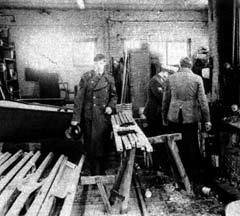
Andreas Baader is brought to Berlin to testify in Horst Mahler's trial. While on the stand, Baader takes the opportunity to publicly announce a hunger strike for all Baader-Meinhof prisoners. Word quickly spreads to the captured terrorists held in over ten different prisons across the Federal Republic.
A bomb explodes in West Berlin’s British Yacht Club, killing an elderly German boatbuilder, Irwin Beelitz. Movement 2 June claims responsibility, indicating that the attack was in support of the Irish Republican Army.
January, 1972 Cologne
posted in 1972, Timeline |
A Cologne policeman pulls over a BMW 2000 with Berlin plates. Knowing of the Baader-Meinhof Gang’s love of BMW’s, the policeman is cautious and points his gun at the car’s driver as he asks for the driver’s registration. Andreas Baader, the car’s driver, leans over, reaches into the glove compartment and pulls out a gun — and shoots at the policeman. Baader escapes, and the cop is uninjured.
January 10, 1972 Federal Republic of Germany
posted in 1972, Timeline |
Der Spiegel publishes a letter by future Nobel laureate Heinrich Böll, in which he decries the Springer Press’s Bild newspaper for a recently published headline accusing the Baader-Meinhof Gang of murder. The Bild headline referred to the shooting of police officer Herbert Schoner on December 20. Böll says that Bild’s Baader-Meinhof coverage “Isn’t cryptofascist anymore, not fascistoid, but naked fascism, agitation, lies, dirt.”
Though Bild is quickly proven right in its premature accusations, Böll’s letter helps to elicit a storm of support letters, as well as letters disagreeing with him. After his letter, Böll is forever branded a Baader-Meinhof supporter.

